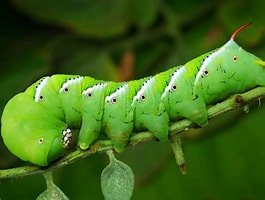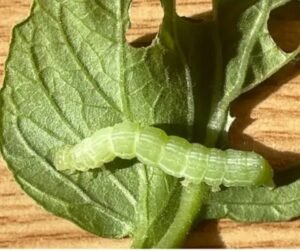
I was in our garden and there it was a big green tomato worm! It aet a whole bell pepper. Now the fight was on. In one week, I found about 30 of them dang green worms.
One of my most despised pests is the Tomato Hornworm. Tomato Hornworms are really big green alien-like caterpillars that can munch through and devastate your vegetable garden. The tomato hornworm is a large green caterpillar with a horn-like tail that does tremendous damage to tomato plants. The hornworms have distinctive creamy-white V-shaped stripes along their sides. growing up to 4 or 5 inches in length, known for their voracious appetite. These common garden pests can cause severe damage in vegetable gardens, particularly in midsummer. However, the destructive caterpillars can be challenging to spot on tomato plants because their green color blends in with tomato foliage.
Most of the time I spot the signs of a hornworm before I see the actual caterpillar. The first things you will notice about a hornworms presence is denuded branches and fruits with huge sections eaten out of them. Hornworms love to eat foliage and since they are such large caterpillars, they have a big appetite which means they poop all over! So, watch for bits of black slimy frass (droppings) on the lower leaves or on the ground.
Getting rid of tomato hornworms for good isn’t easy. It takes patience and vigilance to spot the giant fat green worm-like insects. Usually, handpicking the worms and dropping them in soapy water is the most effective way to eradicate them. However, there are several ways to prevent tomato hornworms or control their numbers.
Tomato hornworms can deprive a plant of its leaves leaving them stripped of foliage and vulnerable to sunburn. In severe infestations, they may also feed on the green fruit of tomato plants, causing direct harm to the crop. They also feed on other plants in the Solanaceae family, including peppers, potatoes, and eggplants.

Tomato hornworms undergo complete metamorphosis, transitioning from egg to larva (caterpillar) to pupa and, finally, to an adult sphinx moth. After feeding and growing as caterpillars, they burrow into the soil to pupate and eventually emerge as moths.
Tomato hornworms develop into large, robust moths known as “tomato hornworm moths” or “five-spotted hawkmoths” (Manduca quinquemaculata). These moths are brown heavy-bodied insects with a wingspan of around 4 to 5 inches. They and feature distinctive yellow spots on the sides of the abdomen.
Natural predators of tomato hornworms include various birds, such as sparrows and finches, as well as beneficial insects like parasitoid wasps, which lay their eggs on the caterpillars.
Tomato hornworms leave behind dark droppings, known as “frass.” You may find these droppings on leaves or the ground near where they are feeding.
Tomato hornworms can be challenging to identify on plants because they blend in well with their environment. However, if you spot one under the leaves or crawling on the stems, you can safely remove the caterpillar by hand. Tomato hornworms are harmless and won’t sting you, despite their stinger-like tail, and they are not venomous to humans
One of the first signs of a tomato hornworm infestation is extensive defoliation. The caterpillars can quickly strip tomato plants of their foliage, leaving behind denuded stems and branches. This defoliation not only impacts the plant’s ability to photosynthesize but also makes the fruit more vulnerable to sunburn.
As they feed, tomato hornworms often leave telltale signs behind. You might notice bare stems and branches where the caterpillars have feasted. Also, they typically excrete large amounts of dark droppings called “frass,” which can be another indicator of their presence.
In severe infestations, tomato hornworms can also feed on the green fruit of tomato plants, causing direct damage to the crop. Their chewing results in irregular holes or scars on the surface of tomatoes.
Tomato hornworms are not exclusively tomato-eaters. They also feed on other plants in the Solanaceae family, which includes peppers, potatoes, and eggplants. So, if you grow any of these hornworm hosts nearby, you might find these caterpillars on them as well.
The tomato hornworm life cycle consists of four phases — egg, caterpillar (larva), pupa, and adult moth. The eggs hatch about seven days after the female lays them. From when the caterpillars hatch until they are full grown it takes around four weeks, and the adult moths live for 10 to 30 days.
During the larval stage, tomato hornworms generally stay on the same plant, devouring the leaves thanks to their voracious appetite. Through most of the larval stages, the tomato hornworm retains its identifying features — creamy white V-markings and a black horn tail.
The third stage of the tomato hornworm life cycle is when it goes underground to pupate. The pupa is a large, reddish-brown segmented cigar-like object with a loop at one end.
As their name suggests, the tomato hornworm favors tomato plants and can quickly devour entire leaves, small stems, and even parts of the immature fruit. When these destructive garden pests attack the fruit, they leave large scars on tomatoes.
However, these ravenous caterpillars will also gorge on eggplant, potato, tobacco, and pepper leaves — all plants from the nightshade family Solanaceae.
However, it’s good to note that tomato hornworms are not dangerous to humans. You can safely pick the worms up without fear of being stung. Additionally, despite their insatiable appetite, the green hornworms won’t bite humans, and their black tail isn’t a stinger. Therefore, physically removing them is the best way to prevent damage.
Have you found any green tomato worms in your garden?
Some links may be affiliated. By purchasing an item from an affiliate link, I receive a small commission – but you are not charged more or less by clicking or purchasing through the link. Thank you for supporting me!
Some of our Post That Might Interest You
- HELLO JUNE 2025
- HELLO MAY 2025
- HELLO APRIL 2025
- DAY LIGHT SAVINGS
- HELLO MARCH 2025
- HAPPY NEW YEAR 2025
- MERRY CHRISTMAS 2024
- CHRISTMAS SURPRISE
- MERRY CHRISTMAS
- HELLO DECEMBER
- WHY FAMILY TRADITIONS MATTER
- My Crochet Journey
- Hello World
